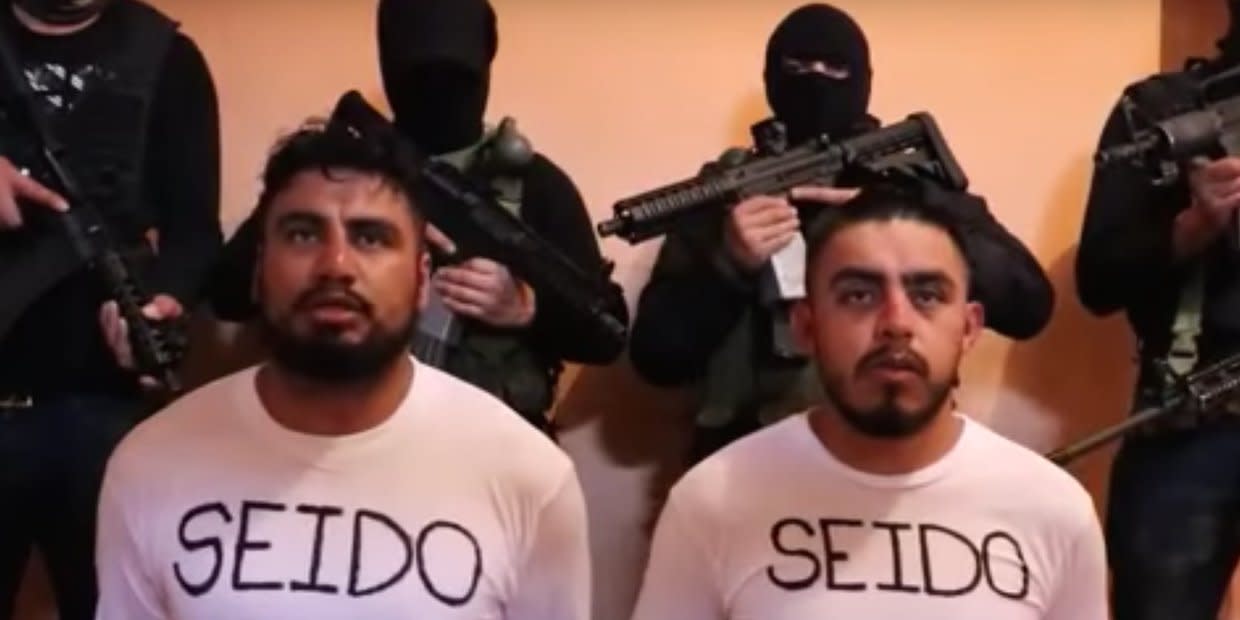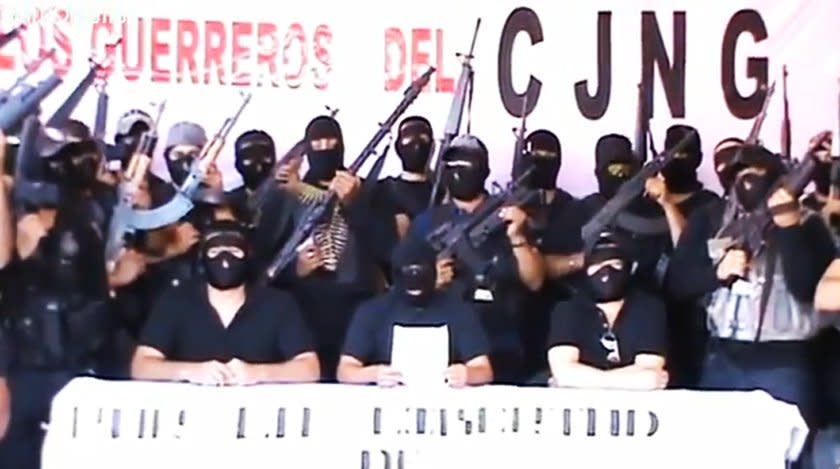Mexico's ascendant Jalisco cartel may be copying the brutal tactics of the once-dominant Zetas

Informe Queretano/YouTube
The alleged abduction and murder of federal agents in Mexico by the Jalisco Cartel New Generation (Cartel Jalisco Nueva Generación – CJNG) resembles the type of operation the Zetas were known for at their zenith. But what do the two groups have in common?
On February 11, a video began circulating online depicting two agents from the organized crime unit of Attorney General’s Office, known by the acronym SEIDO, seated with their hands tied in front of armed men — presumably members of the CJNG.
Agents Alfonso Hernández Villavicencio and Octavio Martínez Quiroz were abducted on February 5 in the Pacific state of Nayarit. In the video, they are forced to criticize the Mexican government’s current security policy and denounce abuses committed by the military.
Youtube Embed:
http://www.youtube.com/embed/ntwv64FbG2s
Width: 840px
Height: 526px
The bodies of the two SEIDO agents were found later found in the city of Xalisco in Nayarit, the Attorney General’s Office said on February 18.
Zeta strategy?
The kidnapping and murder of the SEIDO agents resembles the type of actions of another infamous Mexican crime group, the Zetas. Initially formed by about 30 former members of an elite Mexican army unit, the gang used fear and intimidation to conduct business in defiance of government operations. The Zetas’ actions were planned based on military strategy, and security forces were often the target of their aggression.
Although it is still not certain, all indications are that the slaying of the SEIDO agents is likely the work of the CJNG.

Alexandre Meneghini/AP
In the past, criminal groups in Mexico and other countries in the region have abstained from brazenly attacking security forces to avoid becoming a target of the state. However, Guadalupe Correa, the author of the book “Zetas Inc.,” told InSight Crime that in the case of the Zetas, the spectacle of the group’s violent tactics was due in part to the context of Mexico’s war on drugs under Felipe Calderón, who served as president from 2006 to 2012. During those six years, the cornerstone of the administration’s security policy was to aggressively attack organized crime, and the Zetas quickly became public enemy number one.
Correa added that it is also important to consider the role of certain state governments in fueling the Zetas’ acts of violence by allowing the group to rapidly expand across almost half the country. She believes the situation with the CJNG is no different; it attracted attention towards the end of Calderón’s six-year term and is also known for its violent and aggressive expansion. In less than a decade, the group managed to establish a presence in 14 Mexican states.
For a while the CJNG managed to avoid the government’s attention. But in 2015, the group changed the rules of the game when they downed an army helicopter with a rocket launcher. No other criminal organization had done anything like it, and the CJNG joined the Zetas in taking the federal government by surprise. This was a sign that the CJNG would continue to use the Zeta strategy of intimidation to break into new markets and territories.
In fact, one of the CJNG’s first actions to be made public was the massacre of 35 people in the state of Veracruz in 2011 using military tactics.

REUTERS/Stringer
In the territories that it already controls, the CJNG cartel has carried out violent activities, such as police massacres, forced disappearances and leaving dead bodies on the road. The CJNG, like the Zetas, has also been reported to use the “stewing” method (dissolving a corpse in acid) to discard the bodies of their victims.
In the long term, however, these types of tactics brought the Zetas to its end.
“The Zetas were victims of their own success. They grew too much too fast. Their calling card was brutality. All public, all on display. That inevitably brought them unwanted attention; they became the primary target of the government,” security analyst Alejandro Hope wrote in a column for El Universal.
Today, the majority of the Zetas’ leaders have been neutralized, and the group has splintered. But for Correa this has not meant the end of their criminal model, because it was adapted by other groups, including the CJNG.
The Zeta legacy
Territorial control was always at the heart of the Zetas’ criminal model. To achieve this goal, the group used extortion, collecting “piso,” a payment for any kind of economic activity in their territory, legal or illegal, which allowed the group to become the first to diversify its criminal portfolio beyond the drug trade.
“With this diversification the Zetas transformed organized crime in Mexico,” Correa told InSight Crime.

Screen grab
As the Zetas expanded and diversified, the group began to recruit members from local gangs and delegate new criminal activities to lower-level members. This ended up being counterproductive and causing divisions within the group, which led to its weakening.
While the CJNG adopted the Zetas model, it did so with some modifications. For one thing, the CJNG managed to diversify its criminal portfolio to include oil theft and extorting farmers. However, according to Hope, the CJNG’s modus operandi is still largely based on drug trafficking, and it has not fully mastered extortion.
Unlike the Zetas, the CJNG expansion strategy has not been based on forced recruitment, but rather on alliances with local actors and weakened cartels in advantageous territories like Baja California and Michoacán. Part of the CJNG’s operations now depend on these new groups, which already know the terrain but are not necessarily part of the cartel.
Until now, the CJNG has remained relatively stable. But according to Hope, this group too has schisms in its future. There are already reports of an alleged dissident faction laying claim to territory in the state of Guanajuato. Hope believes that when its leaders fall, the CJNG as we know it will end, and only fragments will remain.
NOW WATCH: The wives of El Chapo's henchmen reveal how they hid and spent $2 billion
See Also:

 Yahoo News
Yahoo News 

